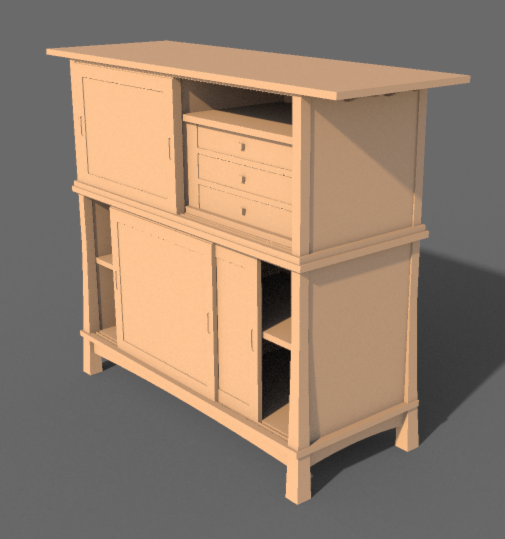A Krenov-inspired sideboard
-
 Just finished modeling a small sideboard designed and built by Seth Janofsky several years ago. It was featured in a 1999 issue of Fine Woodworking magazine. For those who don't know, Janofsky is a graduate of the College of the Redwoods program founded by James Krenov; he now works as a cabinetmaker in the San Francisco area. I've watched Janofsky work, and he's an amazing designer and craftsman.
Just finished modeling a small sideboard designed and built by Seth Janofsky several years ago. It was featured in a 1999 issue of Fine Woodworking magazine. For those who don't know, Janofsky is a graduate of the College of the Redwoods program founded by James Krenov; he now works as a cabinetmaker in the San Francisco area. I've watched Janofsky work, and he's an amazing designer and craftsman.
You can easily see the Krenov influences in this design: thin carcase pieces, flared legs, perfect proportions. The joinery is a combination of clever and crazy. The piece consists of a base and two separate cabinets; the case sides are doweled to the tops and bottoms (a typical Krenov detail); there are small changes in dimensions from one case to the next, creating nice shadow lines. But if it were up to me, I'd have used wedged mortises to join sides to bottom and a housed sliding dovetail to join sides to top. Small brackets to support the top are held with a dovetail in the side.
The drawer section is a separate, removable piece. It doesn't show well in the render, but the drawer sides join the front with half-blind through-tenons, another crazy detail.
Still, the piece is quite attractive, and the modeling was something of a challenge. I'm not sure all the dowel holes align perfectly, despite my best efforts. And I ran out of steam before I modeled the pegs to hold the adjustable shelves in place. This is also an early stab at rendering in Shaderlight.
dh -
Very nice work, David. Very nice.
I like that piece a lot. I could see something like that in my dining room to replace the cherry sideboard from the Amana furniture factory that is there now.
-
Thanks, Dave.
The 1999 Fine Woodworking article had lots of drawings but not enough dimensions, so I had to make up a lot of stuff for the model. Except for the doweling, the joinery is pretty straightforward. Janofsky made the legs the full height of the piece, then sawed them into sections, removing the same amount of material as the top and bottom of the carcases. Your eye sees the smooth curve, even though it's interrupted by the cases. Very cool. He used white oak for most of the piece, with Port Orford Cedar for the door panels.
As I said, I think there are better ways to make the cases than with dowels. You could use wedged mortises top and bottom and cover the through mortises on the top with veneer.I worked with Janofsky once on an article for Fine Woodworking. At the time, he had a smallish shop in a building on the old Alameda Air Station, in Oakland. His shop had been an engine-testing room for the Navy. The walls were very thick solid concrete, the door was equally massive. No windows. That's because the Navy would run aircraft engines at the red line until they exploded. I called the place the Bat Cave.
-
i remember that piece and article too. I really like it as well- it's right up my alley, sort of "contemporary Asian". Nice model. Bet it would look really nice in one of Dave's recent styles...
-
Really like it. How would you go about actually making the flared legs?
-
@nickchun said:
Really like it. How would you go about actually making the flared legs?
I'm 99% sure they're straight on the inside, so it's a relatively simple matter of starting out with an oversize rectangle and cutting the curve- bandsaw+handtools, or router template+bandsaw+flush trim w/router.
-
Maybe I ought to run it through my "process" such as it is.

Nick, Michael is right about the legs. Straight on the two inside faces. Same curve on the two outside ones. The straight faces make the joinery with the rails and side panels a whole lot easier, too.
David, I think I would use something other than dowels for much of the joinery despite what Krenov might have done.
-
Yes please
-
Yes, the legs have two straight faces (on the inside) and two curved faces (on the outside). Janofsky made a template for the curve from MDF and used it as a story stick--he marked it where the leg had to be cut in sections for the case tops and bottoms. He rough-cut the legs on the bandsaw, then cleaned up the curves with a sander, scraper, and planes.
Making the inside faces of the legs straight is the only practical way to make a piece like this. Trying to mate a curved side piece to a curved leg is not a recipe for success. -
Great, thanks for the explanations. I'd love to have a go at making something like that. Maybe a bit ambitious seeing as how I don't have a workshop, if I want to make something I have to wait for good weather and work outside.
Advertisement







